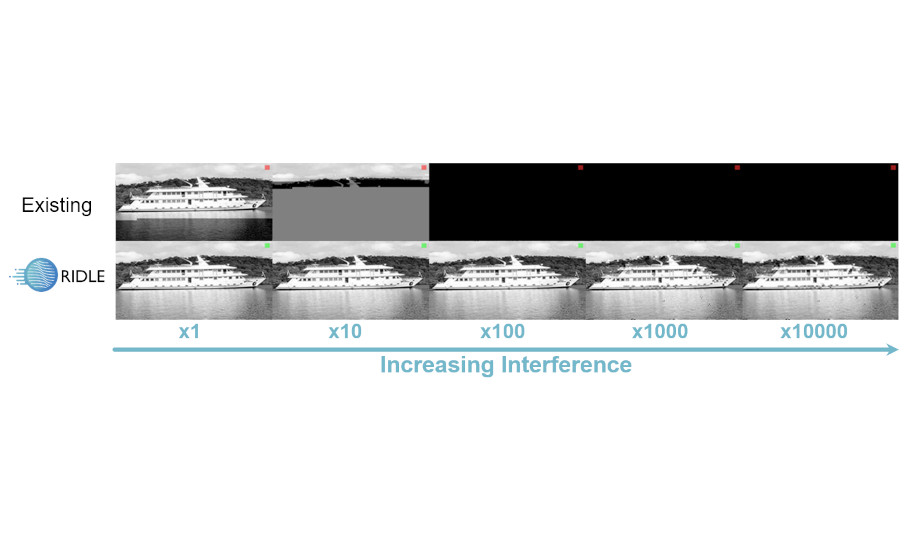Understanding the stakes of maintaining image integrity
From live streaming to video calls, everyone has at some point experienced poor connection, resulting in pixelated images, not being able to see what your screen is supposed to show or even image freeze. In the defence industry, live images are crucial in enabling confident Operator-in-the-loop decisions in missile systems. Often Operators are required to make quick decisions and thus trust in the visualized live streamed images is essential. The consequences of a compromised image can be dramatic, resulting in mission failure.

Example JPEG image resulting from data packet corruption
RIDLE is born from the complex challenge faced by missile operators when managing the wireless transmission of images and video within contested environments.
Beyond the environmental challenges, such as, poor weather, and storms—modern contested battlefields also face challenges from electro-magnetic interference and jamming. From satellites to telephones and computers, wireless data travels everywhere at any given moment, potentially compromising critical images that have been wirelessly transmitted.
Trust at any cost
RIDLE originally stood for “Robust Image processing for Data Link Errors” and is a wordplay with “riddle”. Andy shares his own insight on the name: “You could say our challenge is ensuring that ones and zeros are transmitted and received correctly—as ones and zeros, and not the other way around. Basically, it’s about making sense out of the riddle.” Now, just like MBDA, RIDLE no longer stands for anything and is just the Resilient Image Codec, thus not constraining it’s perceived use-case to those only incorporating Data Links.
One possible solution to a weapon system use-case is “Imagine being an operator making a critical decision when your image suddenly becomes smeared”, adds Matt. “This is why RIDLE was designed to maintain the image integrity, no matter the loss of data.”
In simpler words: in all other compressed image formats, when data gets lost or corrupted during wireless transmission, the resulting de-compressed image may become blurry, distorted, or unrecoverable such that the image content is completely lost. If too many pieces are missing, the structure doesn’t hold. With RIDLE, an image can be compared to a big puzzle, and even if some data is missing, the puzzle can still be solved, thus the overall structural integrity of the picture will remain intact, making it trustable for the receiver.

Illustration of RIDLE versus Existing codec performance for increasing Bit Error Rates
The resilience introduced by the innovation is what stands RIDLE apart from all other image compression codecs that are in the market.
Taking an unprecedented solution to the next step with Smart Visions, the intrapreneurship programme.
When looking back at the development phase of RIDLE, Andy and Matt acknowledge the impact of the Smart Visions programme and the support of MBDA in bringing the concept to another level. “Before Smart Visions came along, we had two years of internal research and development funding to get to the point where we almost had a proof of concept. The Smart Visions process has enabled us to rapidly accelerate the development of the technology to get it to the point where it's actually a standalone product ready for both the commercial markets but also MBDA.”
Smart Visions also brought to the team a business and marketing strategy. Once the technology is stable, the Smart Visions programme enables experts to learn commercial skills, allowing them to move from theoretical use to making concrete changes in various industries both within and beyond MBDA.
Then came Becca, who now manages the marketing aspects of RIDLE – a challenge in which she appreciated the opportunity of being supported by the programme: “Trying to sell RIDLE is very different to selling in my usual job within MBDA.”
World’s first
RIDLE is the world’s first resilient image codec. This uniqueness has enabled RIDLE to be filed for eight separate patents, currently three of these have been granted and the remaining five should be following very soon.
RIDLE headlines
- More than 100,000 times more resilient than standard image codecs such as H.264;
- A software only solution thus easy to integrate;
- Guarantees the integrity of the decoded image, such that every pixel appears in the correct position;
- Uniquely resiliently encodes user-defined metadata with the image, guaranteeing synchronisation within a single stream;
- Solves issues of trust in transmitted imagery.
Revolutionising image processing beyond the defence sector
Today, the RIDLE solution is mature enough to be implemented and used. As it was born from a specific need identified within MBDA, we can look ahead to the integration of RIDLE image processing into MBDA’s future systems. But resilient image compression isn’t confined to just the defence industry. Stakeholders from around the world are already in contact with the team to implement the RIDLE solution in their activities. “We’ve received quite a lot of interest for our capability, and are currently working with seven companies, spread across UK, Europe, USA, and Australia”, confirms Becca.
In the long run, the team of experts at RIDLE are aiming to spread their revolutionising technology across multiple industries before further developing the solution. One day, the images on your own screen could possibly be in a RIDLE format… For now, MBDA is their first client, and RIDLE is already tackling brilliantly the current and future challenges of defence.